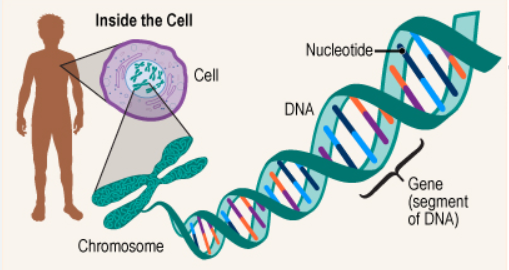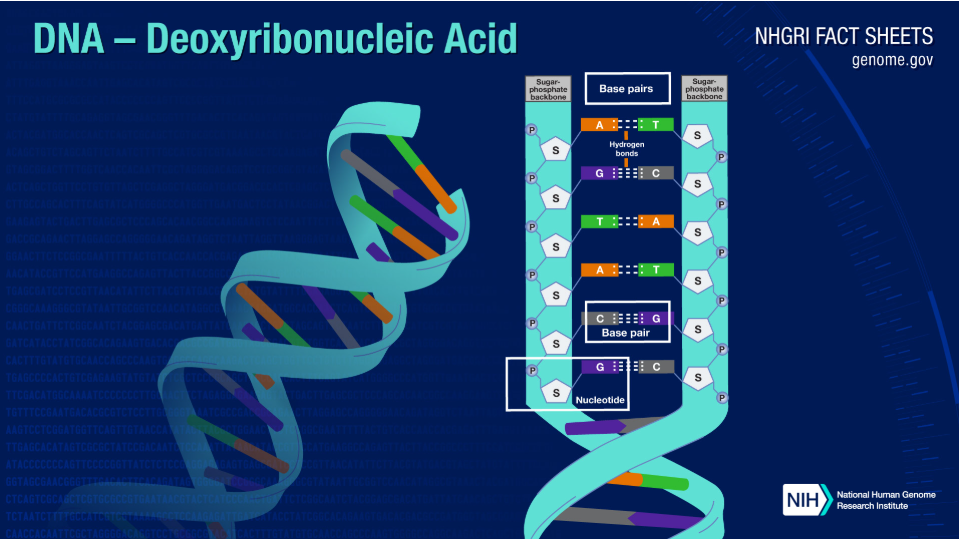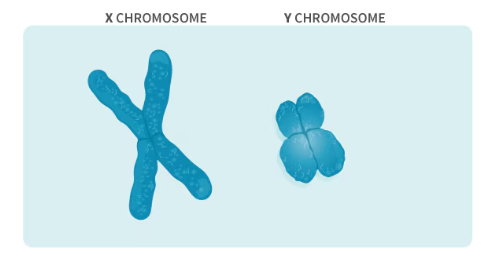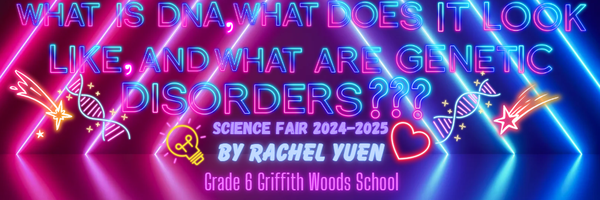What is DNA, What Does it Look Like, & What are Genetic Disorders?
Grade 6
Presentation
Problem
Method
Research
- DNA’s Structure: DNA is made up of 4 different nitrogen bases found in nucleotides, the 4 bases are:
- Adenine (A)
- Thymine (T)
- Guanine (G)
- Cytosine (C)
-
Who and When was DNA discovered?
- DNA was discovered by the swiss biochemist Friedrich Miescher. He observed DNA during the late 1800’s.
-
Why is DNA called the double helix?
- The term ‘the double helix’ is used for DNA because of its twisted ladder shape. Likewise, it has the shape of a double helix (looks like a spring/spiral)! Epigenetics: Epigenetics is a way that you can turn genes on and off without changing your DNA code. Epigenetics can change your health and the well-being of your future generations. Gene therapy: Gene therapy is a type of treatment that uses genes to prevent or fight diseases. That may include adding ‘good genes’ to someone who has a disease, replacing genes that aren’t working properly, or blocking a gene that is generating a problem. Several types of gene therapy are already available. There are many other types of gene therapy that are being studied. Ataxia-Telangiectasia: Ataxia-Telangiectasia is a type of mutation that is passed down from previous generations. Ataxia-Telangiectasia will lead to: ★ Ataxia (unsteady walking). ★ Body movements that are uncontrolled. ★ Telangiectasias (Small blood vessels that are clusters on the skin and eyes). ★ A weak network that helps the body fight diseases and other infections (immune system). There are no specific treatments for Ataxia-Telangiectasia but doctors will most likely recommend different treatments for different stages of Ataxia-Telangiectasia. Cystic fibrosis: Cystic fibrosis (also known as CF) is another type of mutation that is passed down (inherited) from prior generations. CF is when your body creates sticky, very thick mucus. The mucus causes problems in various organs (ex-lungs, pancreas, etc...). Cystic Fibrosis is a life-long condition that is very rare. In CF, doctors will give treatments based on your needs. There are some treatments that all people with CF will need. Hemophilia: Hemophilia is a most often inherited (hereditary) mutation. This is a very rare disease in which there is prevention of your blood to stop it clotting as it should (clotting is what helps you stop bleeding after an injury or cut. If clotting wasn’t in someone’s body, then they may bleed longer than usual or may bleed easily). Hemophilia affects both genders but females usually have a mild hemophilia and can pass the gene to their future generations while males are more often affected by hemophilia. There are a lot of ways to treat hemophilia! Sickle Cell Disease: Sickle cell disease is a hereditary mutation which is when red blood cells are not shaped as they should (red blood cells are a round shape but in sickle cell disease, they are shaped like crescent moons or sickles). The sickle shaped cells are sticky and stiff which block mini blood vessels when they form clumps. That will lead to organ damage and pain because when the sickle cell shaped cells get stuck together, they will stop blood from moving as it should. The sickle-shaped blood cells break down faster than normal red blood cells (too few blood cells) which is a condition called anemia. Sickle cell disease is a lifelong condition with many different types of treatments in a treatment plan. There is only one scientific cure for sickle cell disease so far.
Data
|
Actions: |
Will lead to: |
|
Smoking |
A higher risk of asthma and lung cancer. |
|
Physical Activity |
Lesser risks of some types of cancer. |
|
Overweightness or diabetes during pregnancy |
A baby who will be overweight or very likely to get diabetes in later life. |
|
Exposure of chemicals |
Creating a higher risk of cancer |
|
Emotional stress that is long-lasting |
Will have mood problems in later life. |
|
Not eating enough during early life |
Fatness or overweightness in later life |



Conclusion
My hypothesis was accepted because as found in my research, scientists are working on new ways to cure genetic disorders. Such as epigenetics, and gene therapy! Most of the types of genetic disorders use treatments that help make it less painful. For example, Cystic fibrosis, hemophilia, sickle cell disease, and ataxia-telangiectasia! Overtime, scientists have found more and more information on how to get rid of genetic disorders!
Citations
https://kidshealth.org/en/parents/gene-mutations.html
Science Fair 2024-2025 Timetable-Rachel Yuen
Every Day Science Fair To-Do’s!-Rachel Yuen
Science Fair Vocabulary 2024-2025-Rachel Yuen
Weekly Science Fair Goals!-Rachel Yuen
https://www.genome.gov/human-genome-project
https://www.ancestry.com/c/dna-learning-hub/x-dna
https://www.britannica.com/science/zygote
https://www.genome.gov/genetics-glossary/Gamete#:~:text=00%3A00,one%20copy%20of%20each%20chromosome.
https://dictionary.cambridge.org/dictionary/english/nucleic-acid
https://dictionary.cambridge.org/dictionary/english/phosphorus
https://www.goodreads.com/book/show/55977962-animated-science (I have a copy of this book which provided some of my research pg.100, 6, 7, 10, 11, 124).
https://www.genome.gov/genetics-glossary/Organ#:~:text=In%20biology%2C%20an%20organ%20(from,lungs%20are%20examples%20of%20organs.
https://www.webqc.org/molecular-weight-of-OPO%28OH%292.html
https://www.cancer.gov/publications/dictionaries/cancer-terms/def/urethra
https://dictionary.cambridge.org/dictionary/english/bladder
https://dictionary.cambridge.org/dictionary/english/excreted
https://www.oed.com/dictionary/oxidation_n?tab=factsheet
https://dictionary.cambridge.org/dictionary/english/oxidation
https://dictionary.cambridge.org/dictionary/english/oxidizing
https://dictionary.cambridge.org/dictionary/english/alkyl
https://www.cancer.gov/publications/dictionaries/cancer-terms/def/hereditary
https://www.genome.gov/human-genome-project (in depth of project)
https://www.oed.com/search/dictionary/?scope=Entries&q=fundamental&tl=true
https://www.cancer.gov/publications/dictionaries/cancer-terms/def/cell
https://www.cancer.gov/publications/dictionaries/cancer-terms/def/genome
https://www.genome.gov/genetics-glossary/Ribonucleic-Acid-RNA
Then press on ‘Do humans have RNA in their body?’ you should then see this…
https://study.com/academy/lesson/atp-definition-molecules-quiz.html (watch video until it says you need an account:)
https://www.scribbr.com/research-process/research-question-examples/
https://www.scribbr.com/research-process/research-questions/
https://dictionary.cambridge.org/dictionary/english/correlation
https://youtu.be/-o8-YaVI9pA?si=lzo_sqjFmoRMh7vL
https://platform.cysf.org/project/cb1511e3-708d-41e3-9329-5278eb9cb895/
https://platform.cysf.org/project/dfcdd92e-2f84-4420-b61b-a82c87ca97e0/
(Just the highlighted part…)
https://www.cancer.gov/publications/dictionaries/cancer-terms/def/cell-division
(You should see that when you press in the link above, that is where I got my information from!)
https://www.dictionary.com/browse/parent-cell
https://www.cancer.gov/publications/dictionaries/cancer-terms/def/protein
https://www.developingexperts.com/glossary/bound
https://dictionary.cambridge.org/dictionary/english/assemble
https://www.vocabulary.com/dictionary/principle#:~:text=A%20principle%20is%20a%20kind,guide)%20most%20people%20and%20businesses.
https://www.genome.gov/genetics-glossary/Enzyme#:~:text=Definition,is%20used%20over%20and%20over.
https://my.clevelandclinic.org/health/body/24585-cytokines
https://my.clevelandclinic.org/health/symptoms/21660-inflammation
https://www.oxfordlearnersdictionaries.com/definition/english/obstinately
https://my.clevelandclinic.org/health/body/22971-antibodies
(You should see this when you press the link above, that is where I got my information from!)
https://my.clevelandclinic.org/health/body/24425-lipids
https://www.cancer.gov/publications/dictionaries/cancer-terms/def/red-blood-cell
https://my.clevelandclinic.org/health/body/22818-bone-marrow
https://www.cancer.gov/publications/dictionaries/cancer-terms/def/hemoglobin
https://my.clevelandclinic.org/health/body/21871-white-blood-cells
https://my.clevelandclinic.org/health/body/22313-neutrophils
https://my.clevelandclinic.org/health/body/23342-lymphocytes
https://my.clevelandclinic.org/health/body/23402-eosinophils
https://my.clevelandclinic.org/health/body/23256-basophils
https://my.clevelandclinic.org/health/body/22110-monocytes
https://dictionary.cambridge.org/dictionary/english/suspend
(Scroll down until you see this, this is where I got my information from!!!)
https://www.mayoclinic.org/tests-procedures/bone-marrow-transplant/in-depth/stem-cells/art-20048117#:~:text=Embryonic%20stem%20cells.&text=These%20are%20pluripotent%20(ploo%2DRIP,repair%20diseased%20tissue%20and%20organs.
https://www.cancer.gov/publications/dictionaries/cancer-terms/def/pluripotent-stem-cell
https://dictionary.cambridge.org/dictionary/english/unicellular
https://www.cancer.gov/publications/dictionaries/cancer-terms/def/pancreas
https://www.cancer.gov/publications/dictionaries/cancer-terms/def/gland
https://kidshealth.org/en/parents/glucose.html
https://www.genome.gov/genetics-glossary/Messenger-RNA-mRNA
https://dictionary.cambridge.org/dictionary/english/diffraction
https://kidshealth.org/en/parents/about-epigenetics.html?ref=search
https://www.cancer.gov/publications/dictionaries/cancer-terms/def/asthma
https://www.cancer.gov/publications/dictionaries/cancer-terms/def/bronchial
https://dictionary.cambridge.org/dictionary/english/refined
https://kidshealth.org/en/parents/gene-therapy.html?ref=search
https://www.google.com/search?q=how+many+atm+genes+are+in+your+body&oq=&gs_lcrp=EgZjaHJvbWUqCQgCEEUYOxjCAzIJCAAQRRg7GMIDMgkIARBFGDsYwgMyCQgCEEUYOxjCAzIJCAMQRRg7GMIDMgkIBBBFGDsYwgMyCQgFEEUYOxjCAzIJCAYQRRg7GMIDMgkIBxBFGDsYwgPSAQkxOTA5ajBqMTWoAgiwAgE&sourceid=chrome&ie=UTF-8&safe=active&ssui=on (very useful search that helped me understand)!
https://geneticprogramming.com/
(You should see this when you click on the link above… This is where I got my information from)!
https://my.clevelandclinic.org/health/diseases/10985-ultraviolet-radiation
https://kidshealth.org/en/parents/cf.html
https://kidshealth.org/en/parents/hemophilia.html
https://kidshealth.org/en/parents/sickle-cell-anemia.html
(Info found here)!!!
(Info found in the circled info)!
(Info found here)!
https://dictionary.cambridge.org/pronunciation/english/folic-acid
https://www.howtopronounce.com/voxelotor
https://www.howtopronounce.com/oxbryta
https://www.howtopronounce.com/crizanlizumab
https://www.howtopronounce.com/adakveo
(Info found as above)
https://youtu.be/2UElC_YZ0Eo?si=zCunmJKt3MlfuhwZ
(Info found here)!
(Info found here)!
(Info found here)!
(Info found here)!
https://dictionary.cambridge.org/us/dictionary/english/bulky
https://dictionary.cambridge.org/dictionary/english/nitrogen

